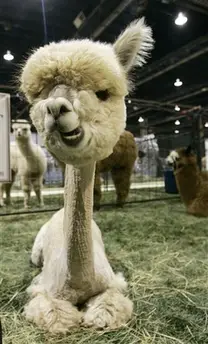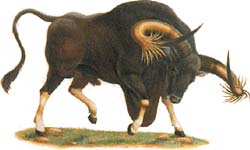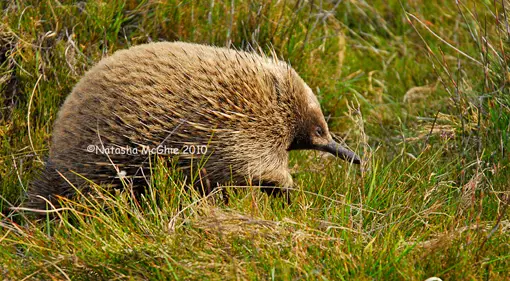Long Nosed Bandicoot
A Bandicoot is a marsupial, like opossums and kangaroos.
This means that they carry their children in pouches.
The reason for the Bandicoot’s name is fairly clear when you see the length of his nose.
Two aspects of a long nosed bandicoot make it different from other marsupials.
They have a great many incisor teeth, which means they eat both insects and flesh.
Additionally their second and third toe grows together, a great deal like the kangaroo.

Long Nosed Bandicoot
Bandicoots hop on their back feet like kangaroos, except they are a great deal smaller.
A bandicoot is about 20 inches long when fully grown and weights about 3 pounds.
They are brown, or grayish brown in color, and can be striped or even orange colored.
Bandicoots are nocturnal animals, hunting and moving around only at night, for which their coloration is excellent.
Normally this is the only time you will see them, as they spend most of the day time hiding, in either crevices in the ground, overturned trees or logs, or tunnels.
Bandicoots dig holes with their paws, big enough to let their noses reach in to gather insects that are hiding or buried under logs or rocks.
They will often be heard to make snuffling sounds while looking for their food and when they find it, they make a loud grunting noise rather like a piglet.
Bandicoot babies are born in the springtime, although they can be born nearly any time all year.
A female Bandicoot has about 3 little ones, who stay in the pouch, facing backwards while they nurse inside the pouch.
The female Bandicoot is capable of having babies as often as every 7 weeks throughout the year if the weather stays nice, and has about 8 nipples inside her pouch even though she only has two or three babies at a time.
The young will stay inside the pouch nursing for about 8 weeks, and then emerge.
Less than 3 months old they are independent and out on their own.



The long nosed bandicoot is the sweetest animal EVER! i’m ding a report on i t because i think it is so sweet!
hi my name is Leanne miller from Australia in Queensland anyway we sat up late tonight as my seven year old son loves wildlife and wants to work at a zoo he says .. I’m a carer and anyway we sat outside with torch listening and looking for wild animals in trees and around as we live in the country on acres.. We were watching the possums at first listening to them fight over the bird seed that they pinch from our bird feeder.. Listening and shinning the torch everywhere to look around.. The last month we have been seeing scurrying of images of animals through the grass we didn’t know what it was.. When we looked on our front lawn there was a bandicoot we watched what she did and took notice of her for an hour.. Then I ran inside and grabbed my camera while she was still there.. Trying to find the backup light on the camera so I could take a clear picture well I didn’t find it.. Anyway grabbed my camera and my son took the low battery torch and shinned to the side of the bandicoot so I had some back ground light to take a picture.. Anyway didn’t come out good so we moved closer and closer to her about a meter away and she didn’t do anything kept eating and wasn’t to scared, so a bit closer I got. Took the photos some anyway till she got frightened by a dog barking.. She ran under the tree, so we left her went inside and transferred my pictures onto computer and I zoomed in edited it for my son and I to see better.. To our surprise we can see a little image at her back foot a tiny baby.. Which we think it is no fur sitting under its mum… Quite small so you need to zoom in.. With pointy ears and black spot on nose with slight point to it.. We were amazed.. So trying to find info and pictures of pictures of new born bandicoots and found your site, but still haven’t found any.. If you give me your email Ill send you the photo and you can have a look and tell me if what we see is really a baby bandicoot..OK I look after kangaroos and possums and a baby crow that my husband looks after its his mate.. The possums and the kangaroos have all gone to the wild and also have a sugar glider and raised it from a baby and is doing well.. We also found 2 baby bilbys in our shed where we keep hay for stock feed, but there poor little tiny bodies were that cold they died, they were nearly dead when I got to them but knew the bilbys were endangered so tried my hardest.. Will still think the mother still hangs around here maybe she might have more as the ones that died were separated from the mother… Anyway better get to bed could you please help me if you can, and send your email address to – millersfamily@bigpond.com (this is the family’s email address.. Thanking you Leanne miller…